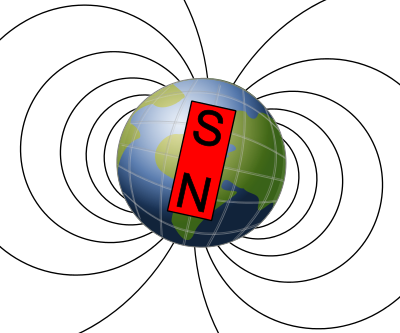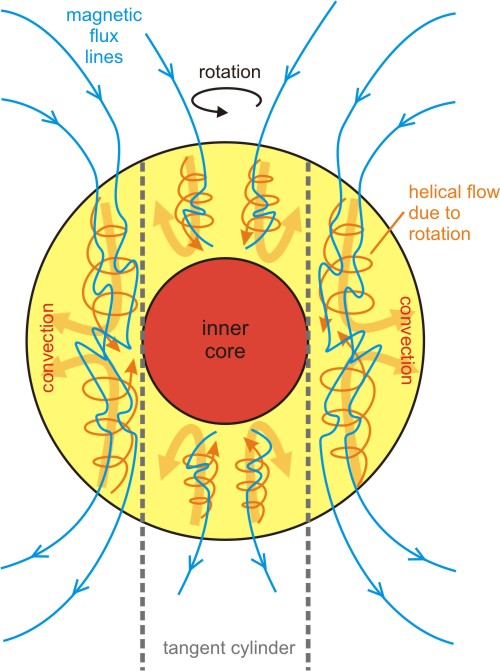Earth's Magnetic Field: Difference between revisions
No edit summary |
No edit summary |
||
| (One intermediate revision by the same user not shown) | |||
| Line 15: | Line 15: | ||
Now, the above explanation is a simplified one. The ‘’dynamo effect” is what is believed to cause the electric current that generates the magnetic field. Molten metal, like iron, follows the Earth’s magnetic field and generates the electric current. The metals’ interaction with each other produces a charge probably due to friction and convection drives the flowing of the molten metal. The convection is most likely due to radioactive decay within the Earth’s core and this in turn produces heat to generate the convection. Once the magnetic field from the flowing of molten metal is produced, it and the already produced magnetic field form an even stronger field along the Earth’s rotation. Also, the produced magnetic field will cause more flowing of the core which will then create another electric current which will then produce another magnetic field. This cycle continues and cause the Earth’s magnetic field to be self-sustaining. So, simplified convection causes the churning of the outer core and this forms a magnetic field which forms more electric currents to form more magnetic fields. | Now, the above explanation is a simplified one. The ‘’dynamo effect” is what is believed to cause the electric current that generates the magnetic field. Molten metal, like iron, follows the Earth’s magnetic field and generates the electric current. The metals’ interaction with each other produces a charge probably due to friction and convection drives the flowing of the molten metal. The convection is most likely due to radioactive decay within the Earth’s core and this in turn produces heat to generate the convection. Once the magnetic field from the flowing of molten metal is produced, it and the already produced magnetic field form an even stronger field along the Earth’s rotation. Also, the produced magnetic field will cause more flowing of the core which will then create another electric current which will then produce another magnetic field. This cycle continues and cause the Earth’s magnetic field to be self-sustaining. So, simplified convection causes the churning of the outer core and this forms a magnetic field which forms more electric currents to form more magnetic fields. | ||
== | ==Solar Winds Effect== | ||
The sun’s solar winds can have an effect on the Earth’s magnetic fields. Solar winds are large clumps of plasma or charged particles that are ejected from the Sun. When these solar winds impact the Earth’s magnetic field, it will cause the field to be distorted and fluctuate in strength. On the side of impact, the field lines compress (strengthening) and on the other side of the planet, the field lines spread further apart (weakening). Also, the field lines will curve which can affect compasses and navigation instruments. The fluctuation of strength can also cause power outages and other undesirable effects on electrical equipment. These solar winds also interact with the gases in our atmosphere. The solar winds can give large amounts of energy to the atoms in the atmosphere and these atoms release electromagnetic radiation. Different atoms release different electromagnetic radiations at different wavelengths. This happens at the poles and the wavelengths are within the visible light range causing a light show called the Aurora Borealis (geographic North Pole) and Australis (geographic South Pole). | |||
==Connectedness== | ==Connectedness== | ||
#How is this topic connected to something that you are interested in? | #How is this topic connected to something that you are interested in? | ||
I was really into learning how the Earth worked when I was younger, like plate tectonics, volcanoes, etc. So, I wanted to now learn about the magnetic field that it makes since i never learned too much about it on my own. I also love the northern and southern lights. It also shows the way electric current can generate magnetic fields and vice versa, and how the magnetic field of the earth is used and how it works with navigation. Also it shows how energy/charge can interact with atoms to produce visible light and how it effects magnetic fields. | |||
#How is it connected to your major? | #How is it connected to your major? | ||
I am a BME, so it is not all that connected to my major, but something i personally enjoy. | |||
#Is there an interesting industrial application? | #Is there an interesting industrial application? | ||
Learning how to make equipment better prepared for solar storms is one big thing. Also, understanding how the earth's magnetic field works could help us understand other planets better. | |||
==History== | ==History== | ||
A German-American physicist named Walter M. Elsasser along with Edward Bullard, a British geophysicist, came up with the dynamo effect in the middle of the 20th century. This theory came from the observations of the orientation of minerals within rocks around the planet. This observation would also later help lead to the theory that the magnetic poles move location over time | |||
== See also == | |||
Pole reversal | |||
Magnetosphere | |||
===Further reading=== | ===Further reading=== | ||
The Earth's Magnetic Field: Its History, Origin and Planetary Perspective by Ronald T. Merril | |||
Reversals of the Earth's Magnetic Field by J. A. Jacobs | |||
==References== | |||
"Magnetosphere." Magnetosphere. Web. 2 Dec. 2015. <http://pluto.space.swri.edu/image/glossary/magnetosphere.html>. | |||
"Dynamo Effect." Dynamo Effect. Web. 2 Dec. 2015. <http://abyss.uoregon.edu/~js/glossary/dynamo_effect.html>. | |||
"Magnetic Field of the Earth." Magnetic Field of the Earth. Web. 2 Dec. 2015. <http://hyperphysics.phy-astr.gsu.edu/hbase/magnetic/magearth.html#c2>. | |||
"Solar Wind's Effect on Earth." PBS LearningMedia. Web. 2 Dec. 2015. <http://www.pbslearningmedia.org/resource/ess05.sci.ess.eiu.solarwind/solar-winds-effect-on-earth/>. | |||
"Charged Particles and Magnetic Fields." Galactic Interactions. Galacticinteractions, 9 Feb. 2012. Web. 3 Dec. 2015. <http://galacticinteractions.scientopia.org/2012/02/09/charged-particles-and-magnetic-fields/>. | |||
Joly, Chris. "Joly Astronomy." Joly Astronomy. 5 May 2014. Web. 4 Dec. 2015. <http://jolyastronomy.com/tag/earth/>. | |||
Catergory: Fields | |||
Latest revision as of 15:09, 5 December 2015
Claimed by Mclark78 (Matthew Clark)
Short Description of Topic
Bar Magnet Comparison

The Earth’s magnetic field acts much like a bar magnet with a north and South Pole. Our compass magnets’ north end will point to the north part of the Earth. But, magnets repel the same charged side, so why does north point north? This is because what we call the North Pole is the geographic north, but the magnetic south and the South Pole is the magnetic north pole. So, the magnetic field lines, if they were visible, would go from the geographic South Pole and curve up and into the geographic North Pole.
Electromagnet Comparison
Unlike a bar magnet, the Earth’s core is far too hot to be magnetic. It is hypothesized that there is electric current flowing in the Earth’s core and this is what generates the magnetic field. This is much like how an electromagnet works. Flowing electric current produces a magnetic field, like having a current go through a wire that is wrapped around a nail. It was from this know relationship and the understanding that the Earth’s core is molten metal and flowing, that lead to the current understanding of how the Earth’s magnetic field is generated.
Dynamo Effect

Now, the above explanation is a simplified one. The ‘’dynamo effect” is what is believed to cause the electric current that generates the magnetic field. Molten metal, like iron, follows the Earth’s magnetic field and generates the electric current. The metals’ interaction with each other produces a charge probably due to friction and convection drives the flowing of the molten metal. The convection is most likely due to radioactive decay within the Earth’s core and this in turn produces heat to generate the convection. Once the magnetic field from the flowing of molten metal is produced, it and the already produced magnetic field form an even stronger field along the Earth’s rotation. Also, the produced magnetic field will cause more flowing of the core which will then create another electric current which will then produce another magnetic field. This cycle continues and cause the Earth’s magnetic field to be self-sustaining. So, simplified convection causes the churning of the outer core and this forms a magnetic field which forms more electric currents to form more magnetic fields.
Solar Winds Effect
The sun’s solar winds can have an effect on the Earth’s magnetic fields. Solar winds are large clumps of plasma or charged particles that are ejected from the Sun. When these solar winds impact the Earth’s magnetic field, it will cause the field to be distorted and fluctuate in strength. On the side of impact, the field lines compress (strengthening) and on the other side of the planet, the field lines spread further apart (weakening). Also, the field lines will curve which can affect compasses and navigation instruments. The fluctuation of strength can also cause power outages and other undesirable effects on electrical equipment. These solar winds also interact with the gases in our atmosphere. The solar winds can give large amounts of energy to the atoms in the atmosphere and these atoms release electromagnetic radiation. Different atoms release different electromagnetic radiations at different wavelengths. This happens at the poles and the wavelengths are within the visible light range causing a light show called the Aurora Borealis (geographic North Pole) and Australis (geographic South Pole).
Connectedness
- How is this topic connected to something that you are interested in?
I was really into learning how the Earth worked when I was younger, like plate tectonics, volcanoes, etc. So, I wanted to now learn about the magnetic field that it makes since i never learned too much about it on my own. I also love the northern and southern lights. It also shows the way electric current can generate magnetic fields and vice versa, and how the magnetic field of the earth is used and how it works with navigation. Also it shows how energy/charge can interact with atoms to produce visible light and how it effects magnetic fields.
- How is it connected to your major?
I am a BME, so it is not all that connected to my major, but something i personally enjoy.
- Is there an interesting industrial application?
Learning how to make equipment better prepared for solar storms is one big thing. Also, understanding how the earth's magnetic field works could help us understand other planets better.
History
A German-American physicist named Walter M. Elsasser along with Edward Bullard, a British geophysicist, came up with the dynamo effect in the middle of the 20th century. This theory came from the observations of the orientation of minerals within rocks around the planet. This observation would also later help lead to the theory that the magnetic poles move location over time
See also
Pole reversal
Magnetosphere
Further reading
The Earth's Magnetic Field: Its History, Origin and Planetary Perspective by Ronald T. Merril
Reversals of the Earth's Magnetic Field by J. A. Jacobs
References
"Magnetosphere." Magnetosphere. Web. 2 Dec. 2015. <http://pluto.space.swri.edu/image/glossary/magnetosphere.html>.
"Dynamo Effect." Dynamo Effect. Web. 2 Dec. 2015. <http://abyss.uoregon.edu/~js/glossary/dynamo_effect.html>.
"Magnetic Field of the Earth." Magnetic Field of the Earth. Web. 2 Dec. 2015. <http://hyperphysics.phy-astr.gsu.edu/hbase/magnetic/magearth.html#c2>.
"Solar Wind's Effect on Earth." PBS LearningMedia. Web. 2 Dec. 2015. <http://www.pbslearningmedia.org/resource/ess05.sci.ess.eiu.solarwind/solar-winds-effect-on-earth/>.
"Charged Particles and Magnetic Fields." Galactic Interactions. Galacticinteractions, 9 Feb. 2012. Web. 3 Dec. 2015. <http://galacticinteractions.scientopia.org/2012/02/09/charged-particles-and-magnetic-fields/>.
Joly, Chris. "Joly Astronomy." Joly Astronomy. 5 May 2014. Web. 4 Dec. 2015. <http://jolyastronomy.com/tag/earth/>.
Catergory: Fields